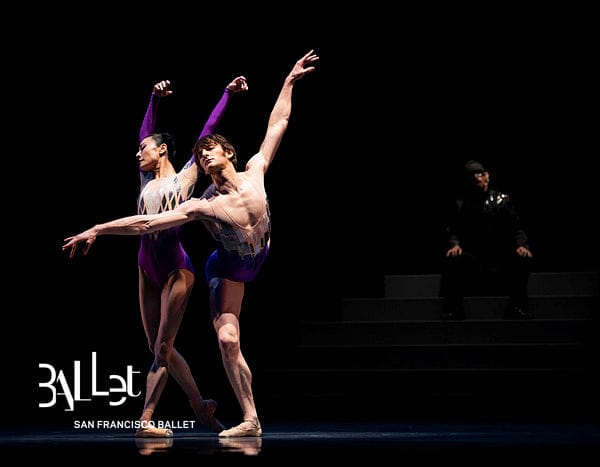A Trinity at Work

“Your Flesh Shall Be a Great Poem” “Bound To” “…two united in a single soul. . .”
San Francisco Ballet
War Memorial Opera House
San Francisco, CA
March 27, 2019
Many ballet companies seem to feel that story ballets bring in much needed, faithful audiences. It would, however, be difficult to imagine that anyone watching SFB’s most recent triple bill would not want to return to see more ballet. After the reprise from last year’s Unbound Festival of Trey McIntyre’s “Your Flesh Shall Be a Great Poem,” my companion exclaimed that she just had found another “favorite contemporary choreographer.” Christopher Wheeldon’s “Bound To”, also from 2018, followed. The evening closed with the world premiere of SFB Resident Choreographer Yuri Possokhov’s “two united in a single soul”. These three works could not have been more different from each other, but each spoke with a crystalline voice of what ballet in the 21st century can be. The art is anything but dead; the audience seemed to agree.
Possokhov had been choreographing for SFB even before his retirement from dancing in 2006 at which point he became the company’s first Choreographer in Residence. It’s not that just he is a skilled craftsman but that his range for thematic inspiration is rich and always based in human experience. More often that not he weaves a narrative through his choreography that anchors a work in a tangible reality. “Optimistic Tragedy” explored life in the Soviet Union, “Swimmer” that in Middle America. He also places his dancers into physical sets that more than just support the choreography. They speak their own potent language and give his “story ballets” an operatic dimension.
For “united” Possokhov went to the myth of Narcissus, as the upfront quote from Metamorphoses indicated. It just may be his best work yet. It also became a starring role for James Walsh, a superb dancer that here was called to engage every sinewy muscle of his beautifully trained body.. Possokhov’s Narcissus was a driven, restless creature, and Walsh’s brilliant intensity of bounding leaps and flying limbs across the stage suggested the character’s desperate passion to find the impossible. Walsh pushed himself to extremes both physically and emotionally in non-stop choreography from one end of the stage to the other that included fractured encounters with other “images” of himself.
Much of the credit for “united” has to go to Possokhov’s brilliant collaborators. For the design, he turned to one of his former SFB colleagues, now filmmaker and designer Ben Pierce, who generated the extraordinary set: a huge reflective globe that suggested the earth. But clairvoyants also might peer into its evolving interior. Gradually, as the inside changed, in an astounding piece of imaginative theater craftsmanship, a tiny live video of our Narcissus, James Walsh, became visible until it got obliterated by something else — I am not going to tell what -- that been growing throughout the work.
For the score the choreographer engaged the Russian-born, now local composer Dario Novo who built her own musical structure around Handel arias, including the exquisite ‘Lascia chi’o pianga’ and ‘cara sposa’. They were beautifully performed by the excellent, though badly miked, counter tenor Aryeh Nussbaum Cohen. Dressed in black, including a face mask, the singer, a ghost like figure, could easily be seen as Narcissus’ inchoate and ultimately futile longing for the impossible. Martin West flawlessly shaped the transitions between the two types of music.
In addition to eight soloists -- a male quartet with Walsh stood out -- the ballet also featured two Duets for Sofiane Sylve/Luke Ingham and Yuan Yuan Tan/Aaron Robinson -- weighted towards the second. Its sheer length and complexity with Tan in every possible lift, turn, contraction and extension challenged Robinson’s ability as a porteur. Tan has been instrumental to Possokhov’s work for years. “two united in one soul,” one suspects, also honored the choreographer and his muse.
The reprise of McIntyre’s “Your Flesh Shall Be a Great Poem” was a welcome opportunity to reconsider this emotionally resonant memoir of the choreographer’s grandfather in the context of his own life. It’s a highly physical, excellently detailed work in which ballet is welcome but not necessarily at home. Its athleticism is softened by tenderness that keeps the work afloat. Last year, I couldn’t quite relate to the score, a series of songs by folk/pop singer Chris Garneau. I now saw – and heard — how essential this music is to “Your Flesh.” Benjamin Freemantle performed the soloist’s role even better — such splendid phrasing, such attention to detail, such a loving embrace of his partner, a four-legged stool.
Seen again also was Christopher Wheeldon’s “Bound To”, his easily-digestible vignettes on what technology (iphones in particular) do to our sense of community, and how much better, gently erotic friendships were among, let’s say, pre-Raphaelite virgins and English school boys. “Bound” left me queasy last year; I still think this is definitely minor Wheeldon. The concept is just too simple though Wheeldon, I have to believe, knew what he was doing. I now think that the piece works best if you can look at with through slightly ironic glasses. Last year’s cast deported themselves well. Particularly notable were Angelo Greco’s frantic loneliness, and Lonnie Weeks’ brilliant repeat rendition of “Trying to Breathe”. Excellent also were Jean-Marc Puissant and Alexander V. Nichols’ diaphonous projections.
copyright © Rita Felciano 2019



